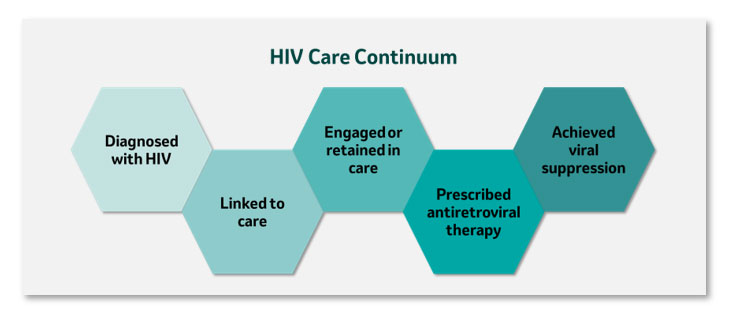Promoting equity in HIV/AIDS care in the Southeastern U.S.
Approximately 1.1 million people in the U.S. are living with HIV, according to the U.S. Centers for Disease Control and Prevention (CDC). Although the overall incidence of HIV has declined, certain populations and geographic regions bear a significant burden of new infections. More than half of all individuals newly diagnosed with HIV in the U.S. live in the Southern Region, and approximately three quarters of those diagnosed are people of color.1
Disparities in HIV care are substantial and persist throughout the HIV care continuum, frequently leading to poorer health outcomes. To help address these disparities, the Merck Foundation supported programs that worked to increase access to high-quality HIV care and helped to overcome the social and environmental factors that influence engagement in care for people of color living with HIV in the Southeastern U.S.
HIV Care Connect
The Merck Foundation supported HIV Care Connect in the U.S., with a commitment of $7 million over five years (2020–2024) to increase access to, and engagement in, HIV care in the Southeastern communities that have disproportionately high rates of HIV.
HIV Care Connect had several goals:
- Improve linkage to and retention in high-quality HIV care for populations most affected by HIV
- Build sustainable collaborations between the health care sector and other sectors to overcome social and environmental barriers to care and treatment
- Improve health outcomes for people living with HIV who face barriers in health care
- Disseminate key findings and program results to advance best practices for improving HIV care across the care continuum

Program sites
Through grants to three organizations, the Foundation supported evidence-based programs to help promote sustainable improvements in the delivery of HIV care.
- Care Resource (Miami, Florida)
- Five Horizons Health Services (Montgomery, Alabama)
- University of Mississippi Medical Center (Jackson, Mississippi)
The University of Alabama at Birmingham served as the National Program Office for HIV Care Connect. It supported the grantee organizations’ programs leading the cross-site evaluation and helping advance efforts to improve HIV care and treatment.
Program approach
Economic stability, neighborhood and physical environment, education, stigma, and social circumstances can all act as barriers to health care among people living with HIV in U.S. communities. Addressing these factors and connecting individuals living with HIV to high-quality care, treatment, and support is critical in achieving and maintaining viral suppression, a key goal of treatment.
HIV Care Connect programs worked to:
- Implement multifaceted strategies to improve long-term engagement in HIV care
- Strengthen multisectoral collaborations to address factors within and outside the health care system that affect access to HIV care and health outcomes
- Engage the community in program development and implementation to ensure that interventions were tailored effectively to meet local needs
HIV Care Connect helped demonstrate how locally tailored approaches can strengthen HIV care delivery and overcome barriers to access in communities heavily affected by HIV.
¹Centers for Disease Control and Prevention. Diagnoses, deaths, and prevalence of HIV in the United States and 6 territories and freely associated states, 2022. HIV Surveillance Report, 2024; vol. 35. http://www.cdc.gov/hiv-data/nhss/hiv-diagnoses-deaths-prevalence.html. Published May 2024. Accessed May 22, 2025
